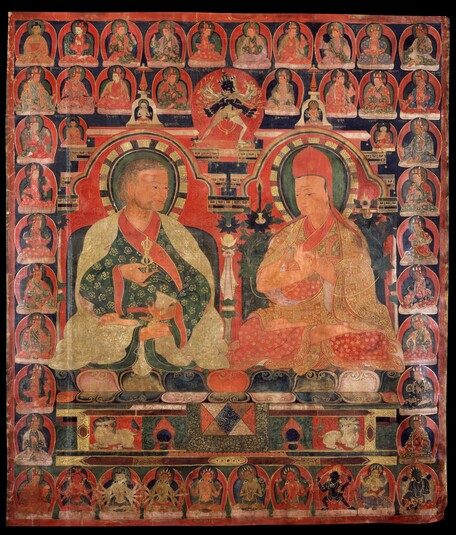
Item: Teacher (Lama) - Dragpa Gyaltsen (Jetsun)
| Origin Location | Central Tibet |
|---|---|
| Date Range | 1500 - 1599 |
| Lineages | Sakya |
| Size | 80.01x68.58cm (31.50x27in) |
| Material | Ground Mineral Pigment, Raised Gold, Fine Gold Line on Cotton |
| Collection | Rubin Museum of Art |
| Catalogue # | acc.# F1997.45.4 |
Dragpa Gyaltsen and Sakya Pandita, uncle and nephew, teacher and student surrounded by the lineage Kings of Shambhala. This composition belongs to a larger set of paintings depicting the Lamdre Lineage of the Sakya Tradition of Tibetan Buddhism in a two figure per composition configuration.
 Sa kya pan di ta kun ga gyal tsen
Sa kya pan di ta kun ga gyal tsen  Biographical Details
Biographical Details
At the center left is Jetsun Dragpa Gyaltsen (1147-1216), gazing to the side with short cropped hair and a beard he holds upright a gold vajra to the heart with the right hand and an upturned bell in the lap with the left. Attired in the garb of a layman he sits in vajra posture above a multi-coloured lotus seat and lion supported throne. Above the head is a small bell shaped caitya with a spire and parasol. Seated inside is white Avalokiteshvara with one face and two hands performing the teaching mudra.
At the right is Sakya Pandita Kunga Gyaltsen Pal Zangpo (1182-1251), with the hands at the heart performing the Dharma teaching mudra while holding the stems of two blue utpala flowers supporting a wisdom sword and Prajnaparamita book at the level of the ears. Attired in the red and yellow robes of a fully ordained monk he wears a red pandita hat with the lappets lying across the shoulders. With the legs folded right over left in vajra posture he sits atop a lotus seat and ornate lion throne decorated with an elaborate backrest. Above the head is a small caitya with orange Manjushri seated inside performing the teaching mudra while holding the stems of two flowers supporting a sword and book. Both figures display a stylized aureola composed of the five coloured flames of pristine awareness. At each side of the upper backrest is a small seated buddha figure.
At the upper center is the tutelary deity Kalachakra, with four faces and twenty-four hands embracing the yellow consort Vishvamata. Above a sun disc and throne seat they stand surrounded by the orange flames of wisdom fire.
At the top left proceeding in rows from left to right are Shakyamuni buddha followed by the first 7 teacher Kings of Shambhala and then continuing with the line of 25 Kulika Kings ending with Rudra Chakra at the lower right side. (The names of the Kings are written in fine gold lettering to the side or beneath each).
Along the bottom are the first 8 Taras from the set of 21 according to the lineage of Suryagupta based on the Tantra of the Twenty-one Praises. Starting from the left; (1) Very Joyful Tara, red, with one face and eight hands, (2) Radiant White Moon Tara with three faces and twelve hands, (3) Gold Coloured Tara with one face and ten hands, (4) Ushnishavijaya Tara, yellow, with one face and four hands, (5) Tara Shouting Hum, yellow, with one face and two hands, (6) Victorious Tara, red, with one face and four hands. All of those are peaceful in appearance and seated in vajra posture. Then follows; (7) Tara Destroying Conflict, wrathful, black, with one face and four hands in a standing posture, (8) Supreme Power Bestowing Tara, yellow, with one face and four hands, riding on a makara (Indian mythic sea creature). At the right side is Tara of the Sandalwood Forest, green, with one face and two hands, seated in a relaxed posture.
Dragpa Gyaltsen, the 5th Sakya Trizin, and Sakya Pandita, the 6th, were two of the founding fathers of the Sakya School of Tibetan Buddhism and members of the Khon family line descending from the Clear Light Realms of Long-lived Gods.
Numbered List: (See Shambhala Kings Names List 1 and Names List 2)
1. Shakyamuni Buddha
2.
3.
4.
5.
6.
7.
8.
9.
10.
11.
12. Red Hand
13.
14.
15.
16.
17.
18.
19.
20.
21.
22.
23.
24.
25.
26.
27.
28.
29.
30.
31.
32.
33.
Letters:
A. Kalachakra
B. Avalokiteshvara
C. Manjushri
D. Buddha
E. Buddha
F. (1) Very Joyful Tara
G. (2) Radiant White Moon Tara
H. (3) Gold Coloured Tara
I. (4) Ushnishavijaya Tara
J. (5) Tara Shouting Hum
K. (6) Victorious Tara
L. (7) Tara Destroying Conflict
M. (8) Supreme Power Bestowing Tara
N. Green Tara of the Sandalwood Forest
Jeff Watt 3-99
Kings: Shambhala Kings Art History
Collection of Rubin Museum of Art: Painting Gallery 3
Tradition: Sakya Teachers
Painting Style: Tibet (Balri)
Tradition: Sakya Founders
Teacher: Dragpa Gyaltsen Page
Kings: Shambhala Kings Main Page
Subject: Margapala Sets (Two Figures)
Kings: Shambhala (All in one painting)
Painting Set: Margapala [24] (RMA/Tamashige)
Subject: Lineage Composition (Greyscale)
Kings: Shambhala Kings (Masterworks, 香巴拉王)
Publication: A Concise History of the Glorious Sakyapa School



